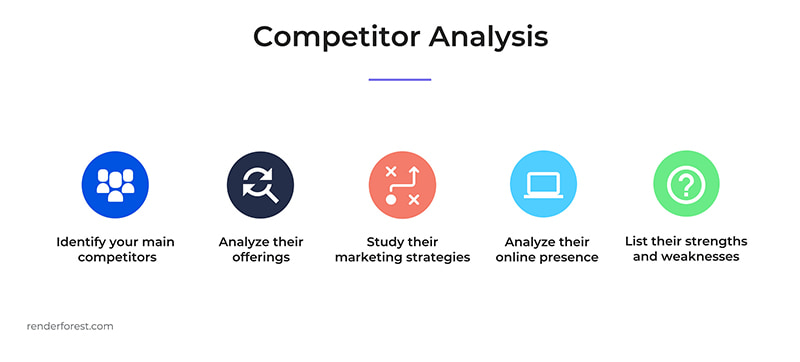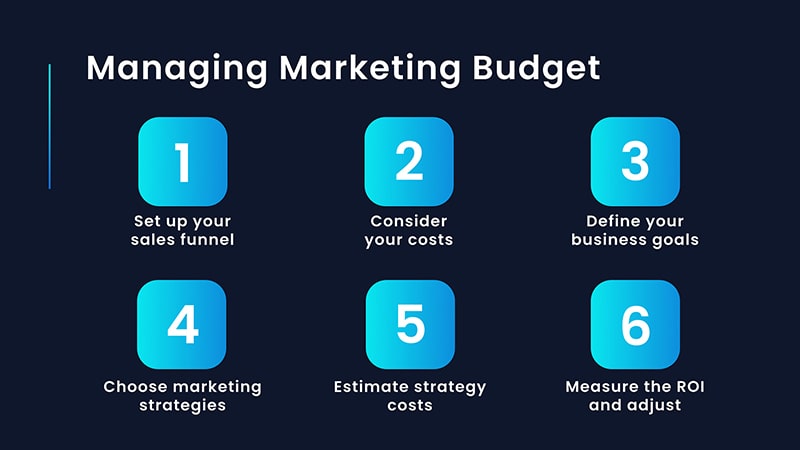
Have you ever wondered what it takes to have second-to-none marketing campaigns? The answer will vary from one person to another: some will claim that it’s all about the team, while others would mention following content marketing tools as the key to success.
A marketing plan holds everything together because, by default, it’s a roadmap that the marketing team will use to succeed. Without a marketing plan, having any serious revenues will be impossible.
75% of marketers reported that using digital marketing strategies had improved their company’s credibility and trust. While it’s true that some companies have seemingly thrived without formal marketing plans, their long-term sustainability is often questionable due to the absence of a clear and comprehensive marketing strategy.
Therefore, it’s crucial to underscore that your business’s core foundation should indeed revolve around a well-planned marketing plan.
Understanding the Essentials: What Is a Marketing Plan?

The concept of a marketing plan is defined in various ways. Still, the one we find most comprehensive is this: a marketing strategy is a strategic document that outlines a business’s marketing strategy for a specific period, commonly a year, six months, a quarter, or even a month. It begins with a meticulous market analysis, encompassing competitor research and the precise definition of a target audience. In today’s digital age, embracing digital marketing, including establishing an online presence and implementing a social media strategy, is no longer optional; it’s essential.
While it’s not uncommon to have distinct marketing strategies for different departments or teams within a company, the ultimate objective is unification. All parts of the business should work cohesively toward a shared goal. A comprehensive marketing strategy encompasses traditional advertising, content marketing, influencer partnerships, and data-driven decision-making. To ensure efficient resource utilization, setting quantifiable objectives and realistic budgets is imperative.
Flexibility is a key attribute of a successful marketing strategy, enabling firms to swiftly adapt to changing consumer preferences, emerging technologies, and dynamic market conditions. This adaptability ensures their competitiveness and relevance in today’s fast-paced business environment.
10 Types of Marketing Plans You Need to Know
Marketing plans can take various forms and serve different purposes depending on a company’s goals and circumstances. Here are several types of marketing plans commonly used in the business world:
- Annual Marketing Plan: This is the most common type of marketing plan and covers marketing strategies and activities for the upcoming year. It includes a comprehensive overview of goals, strategies, budgets, and tactics.
- Product Launch Marketing Plan: Created when launching a new product or service, this plan focuses on the marketing efforts needed to introduce and promote the new offering successfully. It often has a shorter time frame and is highly targeted.
- Digital Marketing Plan: As digital marketing continues to grow in importance, many companies create dedicated plans focused solely on online channels. These plans include strategies for SEO, content marketing, social media, email marketing, PPC advertising, and more.
- Content Marketing Plan: Content marketing involves creating and distributing valuable, relevant content to attract and engage a target audience. A content marketing plan outlines the content strategy, editorial calendar, and distribution channels.
- Social Media Marketing Plan: This plan focuses on social media platforms, detailing the strategies and tactics for building and engaging an audience on platforms like Facebook, Twitter, Instagram, and LinkedIn.
- Event Marketing Plan: When a company hosts or participates in events such as trade shows, conferences, or webinars, an event marketing plan is essential. It outlines promotional efforts to maximize event attendance and impact.
- International Marketing Plan: Companies expanding into global markets require specialized marketing plans considering cultural differences, market research, and localization strategies.
- Nonprofit Marketing Plan: Organizations use marketing plans to promote their mission, attract donors, and raise awareness about their cause. These plans may involve fundraising campaigns, volunteer recruitment, and advocacy efforts.
- E-commerce Marketing Plan: Businesses that operate online stores often have specific plans to drive traffic, boost conversions, and increase online sales. These plans may focus on SEO, PPC advertising, and conversion rate optimization.
- Integrated Marketing Plan: Integrated marketing plans combine various marketing channels and strategies to create a cohesive and unified marketing approach. They ensure consistency in messaging and branding across all touchpoints.
These are just a few examples of the various marketing strategies that businesses may employ. The specific objectives and environment of the business or marketing campaign influence the strategy selection.
Essential Components of Your Marketing Plan Outline
You know it’s vital to develop a strong marketing plan, and importantly, you know the definition of a marketing plan. Now it’s time to look into some of the must-have things in your marketing plan.
Start With a Clear Executive Summary
Kickstart your marketing plan with a concise executive summary designed to captivate your readers. But what exactly is an executive summary?
An executive summary is typically brief, spanning two to four paragraphs. Its primary goal is to introduce your company, its objectives, and its mission. The key here is to craft an executive summary that even individuals unfamiliar with your business can comprehend.
It’s worth noting that while the executive summary can be considered an overview of your marketing plan, it shouldn’t overwhelm the reader with excessive metrics. Be concise and don’t forget to include a clear, succinct marketing mission statement.

Lastly, don’t forget to include a clear, terse marketing mission statement in your executive summary.

Define Your KPIs Based on the Your Goals
Once you’ve outlined your overarching marketing mission, the next step is devising methods to measure progress toward your vision. This is where Key Performance Indicators (KPIs) come into play.
KPIs, short for Key Performance Indicators, represent specific goals that, when achieved, propel you closer to accomplishing your broader marketing objectives. But what distinguishes a good KPI from a poor one?

Consider these two examples and try to identify the better one. Now, let’s examine them.
KPI #1 is the clear winner because it aligns with the SMART goal criteria:

- Specific (indicating a 4 percent increase by the end of 2021)
- Measurable (able to determine goal attainment)
- Assignable (designates responsibility to the marketing team)
- Realistic (not overly ambitious)
- Time-bound (with a deadline of the end of 2021)
KPI #2, in contrast, fails to meet any of these SMART requirements.
Write Down Your User Personas
The next section you must include in your marketing plan is of course the description of your users/customers (buyer persona).

These personas represent the various user types your business serves. Unfortunately, many businesses overlook this crucial aspect, neglecting to invest the effort needed to understand their users. However, this information must be part of your marketing plan to ensure that every department member comprehends the target user profiles.
User personas group your buyers based on characteristics like age, gender, income, education, and more. To emphasize the importance of user personas, consider this hypothetical example:
Imagine you’re a digital marketer tasked with promoting a luxury watch, yet you lack insights into your user personas. Consequently, you might spend exorbitant sums on indiscriminate advertising. Conversely, if you knew that your buyer persona comprises males aged 40+, you could efficiently target this demographic and save resources.
Give a Detailed Overview of Your Competitors
At every stage of your product development, you need to conduct very thorough competitor research. Competitor research is key because it makes you realize what your closest rivals are doing and hence what you can do to perfect your product.

Some companies say that their product has no competitors. Most of the time, those who make this bold claim fail to understand the various types of competitors, namely the direct and indirect competitors.
Direct competitors are easy – these are those that offer a product identical, or almost identical, to yours and are in the same market as you. For instance, Netflix and Amazon Prime are direct competitors. They offer almost identical products – original films and TV series – and compete both domestically (US) and globally. So, it’s hard to miss a direct competitor.
Things, however, become much trickier when indirect competitors are concerned. These ones are easy to miss out on because indirect competitors are those that sell a product that’s quite different from yours, but that is seen as a close or maybe not so close substitute for what you offer.
A good example is coffee versus tea. The products are different, but it’s not uncommon for people to switch between these two drinks.

So, once again, if you think your product has no competitors, think again – you are probably missing a lot of indirect competition that’s happening around you.
But we deviated a little bit. Let’s get back to the marketing plan. We said that a proper marketing plan includes a detailed overview of your competitors and we’ve said the latter could be both direct and indirect.
Why is this important? Simple: imagine a new employee has joined your team. She/he has little or no idea about your company’s product. They want to pick up your marketing plan and see the competitors so that they can learn from them.
Write Down Your Budget
At the beginning of this article, we’ve said that marketing costs are significant for a lot of businesses. Since this is the case, clear budgeting has to be done.
Budgeting is defined as the analysis of the business’s estimated cash inflows (money that comes into the business) from revenues and cash outflows (the money that leaves the business) from expenditures.

There are two primary ways of budgeting.
The first one is the most common as well as a reliable one. It’s done through data extrapolation, which uses historical data to make conclusions about the future. In a nutshell, this is when you use your old revenue and expenditure figures and try to predict your future revenues and expenditure.
As we’ve said, this is the most common way of budgeting as it uses a lot of historical, hence reliable data.
The other way of budgeting is doing it from scratch. This is when you neglect your historical data in favor of estimating your budget based on your preconceptions and intuition. This is pretty dangerous and should be done only if you have no historical data whatsoever (maybe you’ve just started your business).
Whichever way you choose, your marketing plan will need to include a clear section about budgeting.
Define Your Promotional Plan
No comprehensive marketing plan is complete without a well-detailed promotional strategy. Ultimately, the aim is to sell your product effectively, and this requires a robust promotional plan.
Before delving further, let’s clarify the concept of a promotional plan:
A promotional plan serves as a roadmap for leveraging various promotions like email marketing, content marketing, affiliate programs, PR, and more to drive product sales.
Once this aspect is defined within your broader marketing plan, you can allocate responsibilities or request top management to hire individuals as needed. For example, if you opt for an aggressive email campaign but lack an email marketing specialist, you’ll recognize the need to begin the hiring process.

Elevate Your Marketing Plan Design
Now that you have a solid understanding of what a marketing plan is and what it typically includes, it’s time to explore some best practices for effectively designing your marketing plan.
1. Consider Using Infographics
Infographics are powerful visual representations of information, whether verbally or numerically. They have gained popularity as an effective way to convey essential information to diverse audiences, making them valuable to your marketing plan design.
It’s widely acknowledged that people process visual information more efficiently than lengthy text and statistical data. Therefore, incorporating well-crafted infographics into your marketing plan can significantly enhance your plan’s readability and impact. This is particularly beneficial because marketing plans often involve numerous numbers, such as Key Performance Indicators (KPIs) and various metrics.
You can leverage various online graphic design tools, some of which are free, to create compelling infographics. Some marketers have even integrated videos into their marketing plans for added engagement. While video incorporation is optional, it’s worth considering if it aligns with your goals and target audience.
2. Highlight the Most Important Data
If creating infographics is outside your plan, you can still enhance your marketing plan’s effectiveness by emphasizing critical data. While this might resemble the purpose of infographics, it’s crucial to recognize that visual elements significantly prevent your plan from appearing dull and ensure key information is effectively communicated.
By making your KPIs and other essential data stand out, you integrate them seamlessly into your marketing plan’s design, increasing their visibility and impact.
3. Design Your Marketing Plan Pages
To make your marketing plan visually appealing and engaging, consider crafting attractive pages as part of your overall design strategy. However, it’s essential to adhere to specific design principles for optimal results:
- Avoid Excessive Use of Colors
Adhere to the unity-contrast principle in your design. Maintain two dominant colors to create a sense of cohesion and introduce a third color for contrast.
- Include at Least Three Colors
As with the unity-contrast principle, incorporating at least two primary colors and one contrasting color can add visual interest and balance to your design.
- Maintain a Professional Appearance
Remember that your marketing plan will be reviewed by individuals throughout your organization, from junior staff to the CEO. Therefore, maintaining a professional and polished appearance is crucial to ensure it’s taken seriously.
- Carefully Choose Your Fonts
Font selection is critical for readability and professionalism. Opt for easily readable fonts to enhance the overall comfort of reading. Avoid extravagant fonts that can detract from the plan’s professionalism.
Following these design guidelines, you can create a visually stunning and informative marketing plan that effectively communicates your strategy to your team and stakeholders.
Summing Up
In conclusion, a solid marketing strategy is essential for long-term business success. You now better understand its meaning, varieties, and fundamental elements.
Consider including visuals like infographics and ensuring that important information is highlighted to improve the design of your strategy. By adhering to design rules and making appropriate font choices, keep your appearance professional.
Create a designed marketing plan using customizable presentation templates by Renderforest. Choose from hundreds of slides and present your strategies most effectively.
Sign up and try them out today!









